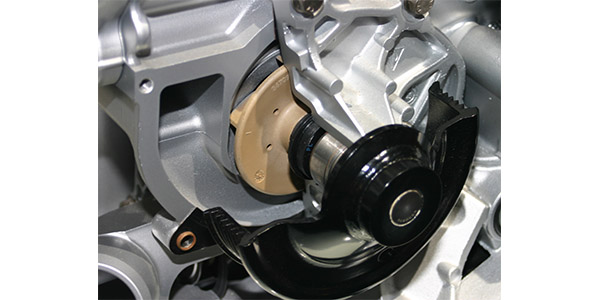
Reading engineering papers tends to be a boring exercise, but they do give a technician like myself a new perspective on how a common automotive cooling system could actually be improved. Of course, our immediate thought is how the cooling system can keep the engine cooler. Not so, according to one paper.
To the contrary, the operative word isn’t about “temperature,” it’s about “powertrain.” Given the advanced state of internal combustion engine technology, some recent cooling system innovations will actually increase engine torque and fuel economy while reducing exhaust emissions. Let me simplify that idea: new cooling system technology will make engines run better and cleaner. So, let’s get on the same page by reviewing some basics.
Coolant Distribution
The distribution of coolant through the cylinder head is controlled by passages cast into the block and by passages stamped into the cylinder head gasket. No matter the system, distributing an even flow of coolant through the engine block, cylinder head and around hot exhaust ports remains the primary goal of any contemporary cooling system.
Thermostats
Ideally, an engine should operate near the boiling point of water to ensure that water, a by-product of combustion, is evaporated from the engine oil during normal operation. Without a high coolant temperature set-point, engine oil quickly turns into a black, highly viscous sludge that clogs vital oil passages and corrodes internal parts. Today, wax pellet- controlled thermostats are the standard method for mechanically managing coolant flow and temperature.
Coolant Bypasses
The thermostat blocks the flow of coolant during engine warm-up, which causes a marked difference in thermal expansion rates between cast-iron engine blocks and aluminum cylinder heads. This inequality of heat transfer can eventually cause metal fatigue in the cylinder head and failure in the cylinder head gasket. The coolant by-pass circuit allows the water pump to warm the engine assembly evenly by circulating coolant through the engine block and cylinder head while the thermostat is closed. Most bypass circuits circulate coolant directly from the pressure outlet of the water pump to the base of the thermostat, which ensures an accurate thermostat opening temperature.
Electric Cooling Fans
The electric cooling fan came into popular use when FWD vehicles with transverse engines appeared in the 1980s. In contrast to mechanically driven fans, electric fans can be fully controlled by the engine management system. Variable-speed, pulse-modulated, electric cooling fans are just another item in the engineer’s toolbox for controlling coolant flow and underhood temperatures.
This vertical-core aluminum and plastic Subaru radiator is typical of modern design. Integrating the radiator with the A/C condenser into a single unit might be the next trend in cooling system design.

Modern Engine Trends
Now we can get to the changes in modern cooling system design. In addition to reducing rotating friction, reducing the swept area of the cylinders and the exposed area of the combustion chamber reduces the thin layer of unburned hydrocarbons clinging to the cylinder’s metallic surfaces, which creates boundary-layer exhaust emissions.
With the aid of computerized engine management systems, exhaust-driven turbocharging is responsible for producing small-displacement engines with very high torque outputs. Aided by gasoline-direct fuel injection, variable valve timing and up to 14:1 compression ratios, these small-displacement engines not only produce higher power outputs with lower exhaust emissions, but, on a more critical economic plane, they also require less underhood space than their high-displacement counterparts. Since cooling capacity is based on horsepower rather than engine displacement, the cooling system must exchange as much heat as a large-displacement engine.
Programmable Cooling Systems
Increasing the mechanical compression ratio of an engines increases power output and fuel economy. But, with the increase of compression ratio, nitrogen oxide (NOx) emissions also increase. Higher compression ratios also require more expensive, high-octane gasoline to prevent destructive detonation, which is the fuel self-igniting around the circumference of the piston under intense cylinder pressure.
While keeping the cylinder head cool is a requisite for preventing detonation at high engine torque, keeping the cylinder head hot is a requisite for increasing fuel economy at low engine torque. Some manufacturers have tried reverse-flow cooling that transports relatively cool coolant from the lower radiator directly to the cylinder head. I don’t have any data to support the results of reverse cooling in normal usage, but the theory is sound. Nevertheless, cylinder head temperature control remains a primary goal of good coolant management.
Electric Thermostats
Cylinder head temperature control is not a steady-state condition. In theory, if cylinder head temperatures can be electronically reduced, compression ratios can be increased. The flip side, if coolant temperatures are excessively reduced, fuel economy and emissions suffer because gasoline fails to vaporize fast enough to produce efficient combustion. Since an engine develops its best fuel economy at high cooling system temperatures and under low-torque conditions, it follows that actually changing engine coolant temperatures to operating conditions improves engine torque and increases fuel economy, which is why we see computer-controlled electric thermostats in some applications.
Electric Water Pumps
Electric water pumps aren’t new. They’re currently used in hybrid applications and in some high-end luxury vehicles. But it stands to reason that a computer-controlled, pulse-modulated electric water pump can operate on-demand and at variable speeds as opposed to the belt-driven water pump that constantly runs at maximum capacity. Another advantage of an electric water pump is that it can be remotely located, which is a plus in today’s crowded engine compartments.
Currently, electric water pumps are used as auxiliary water pumps. This allows engineers to reduce the parasitic drag of a belt-driven pump by reducing its pumping capacity. In this configuration, an electric pump augments water flow during high-demand situations. The electric pump can also be configured to increase or reduce the speed of coolant circulation in response to operating conditions. In any case, we’re probably going to see more electronically controlled water pumps and thermostats in future vehicle powertrains.
Article courtesy Underhood Service.













